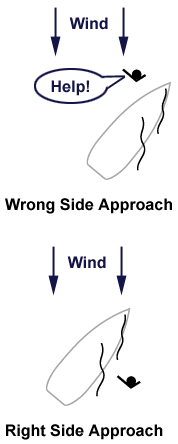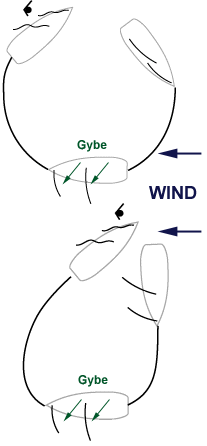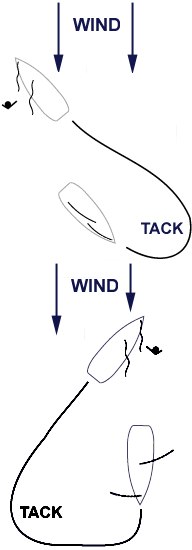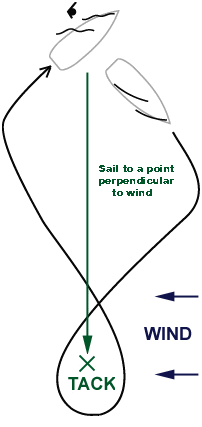
The Final Approach - The Gybe Approach The fastest way to return to the victim when sailing on a close or a beam reach is by Gybing. Continue going your original course for a boat length or so and then bear away into a Gybe. After the Gybe is completed, keep turning in the same direction until you can approach the victim on a close reach or close hauled. Before you reach your objective, ease the sails so the boat will slow down. By adjusting the sails on the final approach, you can bring the boat to a stop along side the person in the water. You may have to take the sails down so the boat won't try to sail away while you're working at getting the victim aboard. In heavy weather it may be too dangerous to attempt a Gybe. If this is the case you may have to use another maneuver such as the figure eight which will be described in this section.

The Tacking Approach - When on a broad reach or a run, the most direct method of returning to the spot where someone falls overboard is the tacking approach. On a broad reach, continue your course for two boat lengths or so and come about. This will leave you lined up for a close reaching approach. On a run you may have to come up to a beam reach before tacking. If you cover about as much distance on a beam reach as you did running, you will be set up for a close reaching approach again.

The Figure Eight or "Q" Turn. In heavy wind conditions or any time it isn't safe to Gybe, you can use the figure eight maneuver. This technique is also useful when you are short handed. If necessary you can release the jib sheets so you don't have to bother with the jib. Although this is hard on the Sail and should only be done in an emergency. Bear away to a beam or broad reach until you are across the wind from the victim. Then tack and continue to bear away again until you can ilne up the boat to approach the victim on a close reach. Pick up the victim as you would in the other maneuvers.

| Contents | 1 | 2 | 3 | 4 | 5 | 6 | 7 | 8 | 9 | 10 | 11 | 12 | 13 | 14 | 15 | 16 | 17 | 18 | 19 |
[Previous Chapter] [Next Chapter]